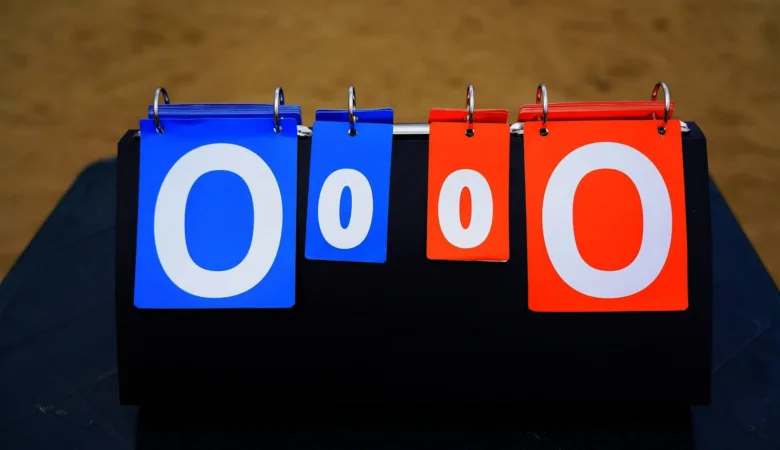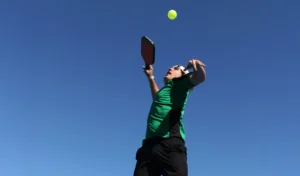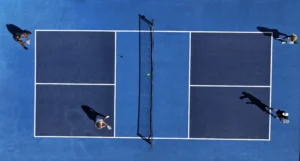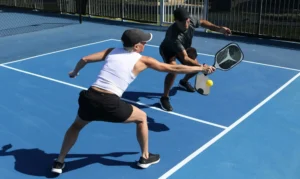
Scoring in pickleball can seem a little tricky at first, especially since it changes slightly depending on whether you’re playing singles or doubles. In this guide, we’ll break down the essential pickleball rules for scoring so that you can follow them with confidence if you’re playing for the fun of it or in competitive play.
Understanding Pickleball Scoring
Once you get the hang of it, pickleball scoring is simple, but there are a few key rules to remember. Games are typically played to 11 points, but you must win by at least 2—so don’t celebrate too early if you’re at 11-10!
Unlike some other racquet sports, only the serving team can score points in pickleball. That means every serve is an opportunity, and serving, scoring, and rotating properly become crucial parts of the game. Master these, and you’ll be well on your way to controlling the court!
The score is always announced before the serve in both singles and doubles. The server should call out the server’s score first, followed by the opponent’s score. In doubles, the server also announces their server number—either “1” or “2.” This keeps everyone on track and ensures smooth gameplay.
How to Keep Score in Singles
In singles, pickleball scoring is more straightforward compared to doubles. Here’s how it works:
- Only the Server Scores: You can only score points if you serve. If you fail to win the rally, the serve goes to your opponent.
- Winning Points: When you win a point, you retain the serve and continue to serve until you lose a rally.
- Switching Sides: The server switches sides after every point. If the server’s score is even, they serve from the right-hand side of the court. If the score is odd, they serve from the left-hand side.
For example, if the score is 3-2 in favor of the server, they would serve from the left-hand side of the court since their score is odd. This alternating pattern helps ensure that both players experience serves from both sides of the court.
How to Keep Score in Doubles
Scoring in doubles is more involved because each team gets two opportunities to serve before handing the serve to the opponents. Here’s how doubles scoring works:
- Two Servers Per Team: Each team has two servers. The player on the right serves first. If they lose the rally, the serve passes to their partner. When the second server loses the rally, the serve is handed over to the opposing team.
- Announcing the Score: In doubles, the score is called in three parts: the serving team’s score, the receiving team’s score, and the server number (1 or 2). For example, “4-3-1” means the serving team has 4 points, the receiving team has 3, and it’s the first server’s turn.
- Starting the Game: At the beginning of the game, only one player from the first-serving team gets to serve. This is called the “first server exception” and helps balance the advantage between teams. After this initial serve, both teammates will have opportunities to serve for the remainder of the game.
- Switching Sides: Like in singles, the serving team switches sides of the court after scoring a point. The server always serves diagonally to the opponent’s court.
Doubles Scoring Breakdown
| Term | Description |
|---|---|
| Serving Sequence | Each team has two servers per turn, starting from the right side of the court. |
| First Server Exception | Only one player from the initial serving team serves in the game’s first turn. |
| Announcing the Score | Call out the serving team’s score, the opponent’s score, and the server number (e.g., “4-2-1”). |
Understanding the First Server Exception in Doubles
After the first round, the serving team gets two serves—one for each teammate—before passing the serve to the opponents. This alternating serve pattern helps ensure fairness and keeps the game moving smoothly.
Scoring Examples
Let’s look at a few examples to make it more straightforward:
Example 1: Singles Play
- The score is 6-4. Since the server’s score is even, they serve from the right-hand side of the court.
- The server wins the rally, making the score 7-4. Since their score is odd, the server continues to serve, now from the left-hand side.
Example 2: Doubles Play
- The score is 3-2-1. The serving team has 3 points, the opponents have 2, and it’s the first server serving.
- The first server loses the rally. The score is 3-2-2, and the second teammate takes over the serve.
- The second server won the rally, scoring 4-2-2. The serving team switches sides, and the second server serves again from the new position.
Tips for Keeping Score
- Announce the Score Clearly: Always announce the score loudly and clearly before each serve to avoid confusion. This is especially important in doubles, where the server number must also be called.
- Use Wristbands or Markers: Some players use wristbands or other markers to help remember who the first and second servers are. This can be very helpful in doubles matches.
- Practice: Keeping score in pickleball gets easier with practice. If you’re new, don’t hesitate to ask your opponents or teammates for a quick reminder during the game.
Common Pickleball Scoring Mistakes (And How to Avoid Them!)
- Mixing Up the Score – It’s easy to lose track, especially in doubles, but calling the wrong score can confuse (and sometimes arguments!). Before serving, take a second to double-check the score—it keeps the game running smoothly.
- Forgetting the First Server Exception – Many beginners miss this crucial rule in doubles: only one player on the first serving team gets to serve before handing it over to the opponents. Keep this in mind to avoid unnecessary faults.
- Not Switching Sides After Scoring – After winning a point, the serving player must switch to the opposite side of the court. Forgetting to do this can result in a fault or even losing your serve—so make it a habit to move after every successful rally!
FAQs About Pickleball Scoring
Can both teammates play doubles pickleball?
Yes! In doubles pickleball, both teammates get a chance to serve before the serve is passed to the opposing team. Here’s how it works:
- The first server starts the serve and continues until their team loses a rally.
- After a fault, the serve then passes to their partner, who also serves until they lose a rally.
- Once both teammates have lost their serve, the opposing team gets the serve.
The exception is at the start of the game—the first serving team only gets one server before the serve switches to the other team. This prevents an early advantage and keeps the game balanced.
By allowing both teammates to serve, the game stays fair, competitive, and strategic, giving each player an opportunity to contribute!
What if I forget to call out the score before serving?
Technically, not announcing the score before serving is a fault, as per official pickleball rules. However, how it’s handled depends on the setting:
- Casual Play: Most players will just remind you to call out the score next time, and you can continue without penalty.
- Tournament Play: If you forget to call the score before serving, the referee or opponent may stop play, and you might have to redo the serve. Repeated violations could result in a fault.
To avoid this, make it a habit to clearly announce the score before every serve—it keeps the game organized and prevents confusion!
Why does only one player serve at the start of a doubles game?
This is known as the First Server Exception Rule, and it’s designed to balance the advantage of serving first.
- At the start of the game, only one player on the first serving team gets to serve. If they lose the rally, the serve immediately passes to the opposing team.
- After this initial round, the game follows normal doubles rules, where both players on a team get a turn to serve before losing possession.
This rule prevents the first serving team from gaining an unfair advantage and ensures a fair start for both sides. Once the game is underway, regular serving rotation applies.
How do I know which side to serve from in singles?
It’s simple—just check your score!
- If your score is even (0, 2, 4, 6, etc.), you serve from the right-hand side of the court.
- If your score is odd (1, 3, 5, 7, etc.), you serve from the left-hand side of the court.
This pattern continues throughout the game, making it easy to determine your serving position. Just remember—even = right, odd = left, and you’ll never be out of position!
How do I remember the server rotation in doubles?
Keeping track of who serves next in doubles pickleball can be tricky, but here are some easy ways to remember the serving order:
- Use Wristbands or Markers – Some players wear wristbands or place a small object on the court to indicate who started serving.
- Follow the Score – The first server is always in the right-hand court when their team’s score is even.
- Establish a Routine – Many doubles teams have a set order (e.g., Player A always serves first, Player B second).
- Communicate with Your Partner – A simple reminder before switching sides can prevent confusion.
Once you get used to the pattern, serving rotation will feel natural and automatic, keeping your team organized and ready to play!
Final Thoughts
Pickleball scoring might initially seem tricky, but once you get the hang of it, it becomes second nature. Whether you’re playing singles or doubles, knowing the scoring system, serving rotation, and proper court positioning is key to keeping the game flowing smoothly.
Mistakes are part of the learning process—so don’t stress if you mess up a call or forget to switch sides. With practice and patience, you’ll call out scores and rotate like a pro in no time. So grab your paddle, hit the court, and most importantly—have fun!


